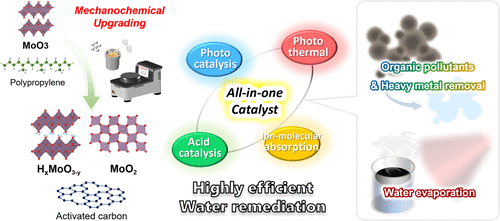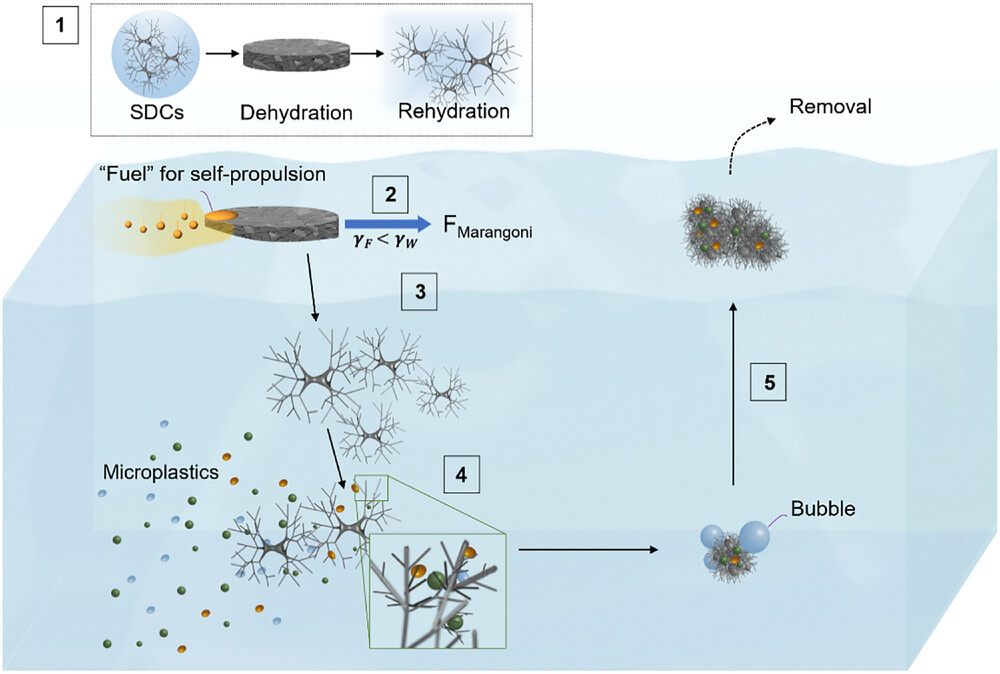#256 - Moon water, Road salt, Chitin microcleaners, Nanomats and more...
Water Water Everywhere...
Hey Readers,
This week we’ve come across a larger set of innovations and news from the world of water. Let us know if we missed anything you happened to see this week. Thanks!
Innovations Roundup
Multifunctional Composite Particles
Researchers work to build solutions that have multiple uses so they can solve two or more related problems in one go. In this case a research team from the Nagoya Institute of Technology (NITech), Japan, have developed a novel method to synthesize multifunctional composite particles. These particles can do two things well - first they have good plasmonic properties, that enables rapid heating using sunlight i.e., it can drive fast evaporation of water with exceptional photo-thermal conversion efficiency. Second, oxygen-containing carbons that remained in the particles adsorb and remove heavy metal ions from wastewater.
The research team built these multi-functional particles by using a planetary ball mill and optimizing milling parameters to transform a commercially available powdered mixture of molybdenum trioxide (MoO3) and polypropylene into composite particles made of hydrogen molybdenum bronze (HxMoO3–y), molybdenum dioxide (MoO2), and activated carbon. Their future plans are to refine their ball milling process to produce similar all-in-one catalysts for water remediation and other applications.
Staying in the realm of solar powered water cleaning, we have a smothering solution from the folks at Ohio State University (OSU). They looked to solve the problem of making titanium dioxide (TiO₂) more efficient. Despite being a great alternative energy source, solar fuel systems that utilize TiO₂ nanoparticles are often power-limited because they can only undergo photocatalysis, or create chemical reactions, by absorbing non-visible UV light. This can cause significant challenges to implementation, including low efficiency and the need for complex filtration systems. This research team realized that adding another element could help TiO₂ be more efficient - Copper (Cu).
Created through a combination of soft chemistry gels and electrospinning — a technique where electrical force is applied to liquid to craft small fibers — the team at OSU constructed thin fiber-like strips of titanium dioxide, then added copper to the material to improve this process. Their new structures, called nanomats, were able to absorb enough light energy to break down harmful pollutants in air and water. Additionally, because this technology doesn’t generate any toxic byproducts like some solar cell systems, nanomats are extremely environmentally friendly. They combine photocatalysis, reusability, and simple deployment in lightweight, easy-to-remove fiber mats that can float and operate atop any body of water - rivers, lakes, or reservoirs, and are even reusable through multiple cleaning cycles.
Hairy microcleaners to pull out microplastics
Researchers at North Carolina State University show proof of concept for a system that, in a single cycle, actively removes microplastics from water. The research starts with soft dendritic colloids – unique, hierarchically-branched soft particles with distinct properties such as the ability to stick to just about any surface – which can be created from a variety of polymers. The cleansing particles in this research are made from chitosan, a biodegradable polymer which comes from processed shellfish shells.
Soft dendritic colloids take the shape of small pellets when dried in droplets suspended over a water-repellent surface. When dropped into water, particles in the pellets separate and spread out to hunt microplastics. To make them easily removable, the microcleaners also contain small particles of magnesium, which makes them bubble up and rise to the surface when reacting with water.
To delay this return trip, the researchers coat the magnesium with an environmentally safe gelatin layer that blocks the magnesium’s reaction with water. Essentially, thicker coats of the gelatin delay the particles from rising to the surface, allowing the microcleaners to pick up more microplastics as they swirl and descend in water. The microplastic-laden microcleaners that have floated up to the water surface can then be collected by skimming.
News Roundup
Lets get into the good and not-so-good news;
The suburban reservoirs that supply 10% of New York City’s drinking water are getting saltier due to decades of road salt being spread near the system. Read more from the folks at CNN
No place is safe from plastic pollution. A group of researchers in Utah have found that plastics and forever chemicals are turning up in rainwater. This is not a US-only problem with scientists saying they have observed plastic-tainted rain falling in China, India, and even remote mountain ranges in France. Read more from the folks at the Cool Down
Staying in Utah, due to prevailing political, pseudo-science views, the state of Utah became the first US state to ban fluoride in public drinking water, despite widespread opposition from dentists and national health organizations. Read more from the folks at the Guardian
The country of Cyprus said it plans to subsidize the construction of private desalination plants at hotels to ensure the tourism-reliant island nation has enough fresh water to see it’s tourists through the busy summer season. Makes you wonder, what about the locals? Read more from the folks at Euronews.com
Thankfully its not all bad news, the European Union and UNICEF came together to help rebuild water and sanitation networks in Sloviansk, Ukraine. Thereby restoring stable water supply to almost 100,000 residents. Read more on the EU Commission website
And finally for this week we have a winner of the £1.2m Aqualunar Challenge, funded by the UK Space Agency. Their goal? - to find innovative solutions to producing drinking water from ice-rich rocks and dust on the Moon!
To see what innovators can do with a microwave oven, a motorized device for feeding woodchips into a barbecue and sound waves, read more from the folks at the Guardian.
That is it for this Friday, until next week,
Peace!







